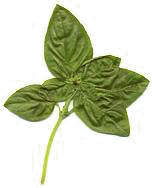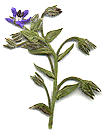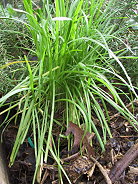Cards In This Set
| Front | Back |
|
NAME: Sweet Basil (Ocimum basilicum)
DESCRIPTION: Sweet Basil is a deliciously aromatic annual herb that grows to about 70cm. The stem is soft and succulent and the leaves bright green. Small white to purple flowers appear in autumn. There are many other forms of basil including Bush Basil (Ocimum minimum), Thai Basil (Ocimum basilicum), Greek Basil (Ocimum obovatum), and cultivars such as the purple-leafed 'Dark Opal', 'Tangy Lemon' and 'Spicy Globe'. ORIGIN: India CULTIVATION: Sow seeds in November or early December or purchase seedlings. Choose the sunniest part of the garden. Soil should be light and well-drained. Add a little lime when the bed is being prepared. As seedlings grow, pinch out regularly to create a compact plant. Harvesting the leaves regularly for culinary use will also keep the plants nice and bushy. If drying, harvest before the plants flower in autumn. USES: Basil is a most delicious herb, especially teamed with tomatoes. (It also grows well near tomatoes.) It lends great flavour to meaty pasta sauces, chicken and vegetable dishes and salads. It is a major ingredient in pesto. The plant emits a wonderful aroma in the garden when watered. As a medicinal remedy it was used to treat maladies of the major organs and also used to tone the skin. Sacred Basil (Ocimum tenuiflorum) is a sacred plant of the Hindus and offerings of basil leaves in Hindu homes are believed to protect the family. |
 Sweet Basil |
|
NAME: Bay Tree (Laurus nobilis) also known as Sweet Bay or Bay Laurel
DESCRIPTION: The Bay Tree is a large evergreen tree which grows to approx. 15m. The leaves are dark green, tough and very aromatic. Sprays of little greenish-cream flowers appear in spring and are followed by small black berries.
ORIGIN: Mediterranean regions
CULTIVATION: The Bay Tree is known for its hardiness and adaptability. It prefers a well-drained position in full sun, though it will also grow in semi-shade. The plants are tolerant of drought, wind and salt-spray. They will self-sow very readily. Bay Trees respond well to pot culture and they are often used as topiary specimens. Heeled cuttings can be taken in spring. (Note: Be certain that you have the correct species. Don't confuse it with the Cherry Laurel which is toxic.)
USES: Bay leaves are used to flavour many meat and fish dishes and are a component of the traditional French seasoning bouquet garni (along with thyme, parsley and marjoram). Dried leaves are most commonly used. Bay oil was used to treat bruises and rheumatism. In ancient Rome and Greece, a wreath of bay leaves was used as a high honour for heroes and scholars - thus the terms "resting on one's laurels" and "poet laureate".
|
Bay Tree
|
|
NAME: Borage (Borago officinalis)
DESCRIPTION: A tall (to 1m) soft-stemmed herb with bristly stems and large hairy leaves. The flowers are brilliantly blue and star shaped.
ORIGIN: Syria
CULTIVATION: Borage is one of the few herbs that prefer a semi-shaded spot, though it will grow in full sun. It needs shelter from strong winds as it is easily blown over. Soil should be moist, loose and friable. Seeds germinate in all seasons except very cold winters. The plant is an annual but self-seeds easily.
USES: Leaves have a fresh cucumber flavour and can be used in salads (use young leaves), drinks and in soups. An infusion of the leaves makes a refreshing tea. The flowers can be added to salads and make beautiful crystallised decorations for cakes and desserts. The flowers are highly attractive to bees and traditionally were symbolic of courage. Embroidered bees and borage flowers were often used to decorate the scarves of knights going into battle.
|
 Borage |
|
NAME: Chives (Allium schoenoprasum)
DESCRIPTION: Chives grow as grassy clumps. The round, hollow foliage has a mild onion flavour and the plants make a pretty edging plant in the garden, especially if allowed to flower. The flowers are very attractive mauve pompoms.
ORIGIN: Possibly native to Britain, but grew extensively in Europe
CULTIVATION: Grow chives from seed sown in spring or in autumn in areas where winters are mild. In cold climates the plants will become dormant over the winter. Clumps of bulbs can be divided in winter and this should be done every few years to prevent clumps becoming congested and unthrifty. Do not allow plants used for the kitchen to flower - nip off all flowering stems.
USES: Pick chives stems from the base and use fresh in egg, chicken and vegetable dishes and in soups and sauces. Freeze in iceblocks or make into chive butter to preserve them. They lose much of their flavour if dried. Chives are often combined with ornamentals such as roses to mask the smell of the plants and confuse pests such as aphids.
|
 Chives |
|
NAME: Aloe vera (Burn Plant)
DESCRIPTION: This mildly spiky succulent grows as a rosette. Clumps grow to about 60cm tall. The leaves are grey green and striated with pale markings. They are very thick and fleshy and ooze a clear, gel-like substance when cut or broken. It bears yellow tubular flowers in summer and is actually a member of the lily family.
ORIGIN: Most probably North Africa
CULTIVATION: Aloe vera is easily propagated from offsets from an established plant. It is possible to raise plants from seed which is sown in spring. The plant requires a well-drained position, protected from hot late afternoon sun and needs more water than many succulents. However it cannot cope with being water-logged, so plant in a raised bed or in a freely-draining pot.
USES: Aloe vera gel has always been highly prized as a treatment for minor burns. It can also be used to soothe sunburn and other skin afflictions. The gel is also used extensively in a wide range of cosmetics and skin-care products. While some claims are also made for its efficacy when taken internally, it is its use for healing and soothing the skin that is well documented.
|
Aloe Vera
|
|
NAME: Ginger (Zingiber officinale)
DESCRIPTION: An erect tropical perennial with narrow leaves that grows from a fat, fibrous, knobby rhizome. The plant grows to around 1m high and the species produces a scaly flower spike of cream and purple flowers. The aromatic rhizome is the part of the plant that is usually eaten, though sometimes young stems are also used.
ORIGIN: Tropical Asia CULTIVATION: Ginger grows best in warm humid climates where the soil is rich, moist but well-drained. Plant in a warm, mainly sunny position. Plants can be propagated in spring from pieces of rhizome containing one or more "eyes" or buds. Plant the rhizome pieces just under the surface of the soil. Ginger requires a soil with added organic matter and fertilizer. Plants can be lifted in late summer and the rhizomes harvested. USES: Ginger is widely used in Indian and Asian cuisine. The rhizomes are peeled and grated into a range of beef, chicken, pork and fish dishes. Ginger is also widely used in curries and finely shaved ginger slices are often used in sushi. Ginger rhizomes can be dried and ground into a powder which is used in cooking biscuits, cakes and gingerbread. Pieces of the rhizome are cooked in syrup and sold as crystalline ginger or glace ginger which are often eaten as sweets or baked into cakes and muffins. Ginger also has medicinal properties and helps to alleviate nausea, especially from travel sickness and stomach ache. It has anti-bacterial and anti-inflammatory properties |
 Ginger |



